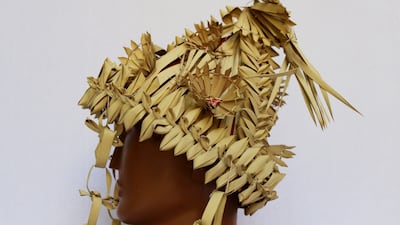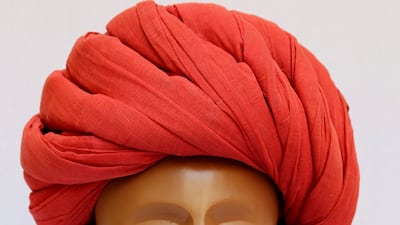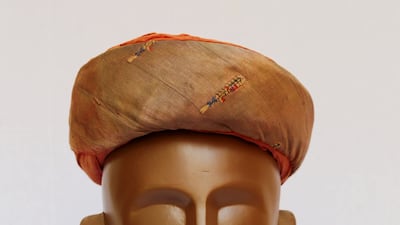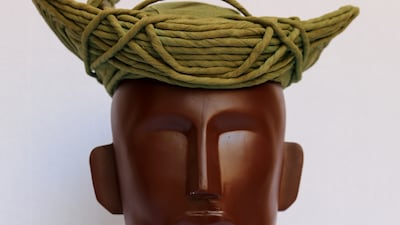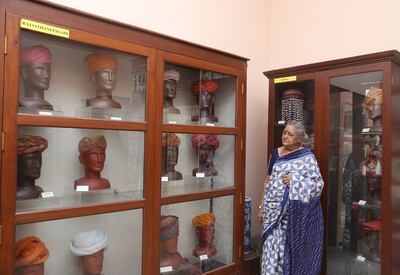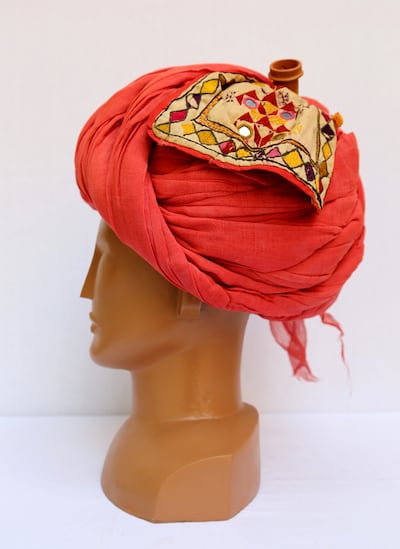Nestled within the dazzling Lakshmi Vilas Palace in Vadodara, Gujarat, a 200-hectare royal residential complex four times the size of Buckingham Palace, is the Maharaja Fateh Singh Museum.
Once the official residence of Gujarat’s illustrious Gaekwad family, the 19th century mansion today houses rare works belonging to the royal household’s personal collection.
It features European Renaissance and Rococo paintings, portraits, marble busts and more than 30 original paintings by celebrated Indian artist Raja Ravi Varma, as well as artefacts from across the world, including Chinese and Japanese porcelain displayed over two floors.
Adding to the visual enchantment is a fully functional toy train – the world’s smallest locomotive engine, once owned by a Gaekwad prince – kept in the sprawling gardens.
However, the museum’s most fascinating section is its Headgear Gallery – a staggering collection of 300 vibrant pieces of headwear from different Indian states including Gujarat, Rajasthan, Madhya Pradesh and Maharashtra. Known variously as feta, pugree, safa or topi in local languages, they were collected by the late Maharaja Ranjitsinh Gaekwad, Vadodara’s titular head from 1988 to 2012, during his sojourns.
Among the exhibits is a rare turban worn by the Gaekwad kings, made from 38 metres of cloth, encrusted with pearls and semi-precious gems; a humble cotton topi (cap) of a medieval tamashagir (street performer) as well as ceremonial headgear of the royal bridegrooms. A pugree of the Chouhan groom from Rajasthan with a triangular pointed shape is embellished with four long, knitted tassels.
The collection also demonstrates a wide range of fabrics and techniques used in crafting the headwear. Silk, cotton, satin as well as plant fibres, have been employed as well as sundry crafting techniques, further highlighting the artistic ingenuity behind each piece. These include the use of the sophisticated Bandhani and Muthra criss-cross tie dye methods as well as Kuchhi and gold Zardozi embroidery.
Manda Hingurao, the Headgear Gallery’s curator, tells The National: “The gallery project was initiated by Maharaja Ranjitsinh Gaekwad in the 1980s and took years of research and curation.
“So passionate was the maharaja about the semiotics of headgear that he even undertook an extensive doctoral research on this topic. The gallery was opened to the public in 2015 in his memory after he passed away in 2012. Apart from national and international tourists, we’re also attracting footfall from academics and researchers.”
India has perhaps the most eclectic headgear in the world, with different communities and states having their own signature ones. From the Rajputs to the Mughals, and the Sikhs to the Marathas, each community wore variegated headwear further influenced by local customs, religions, topography and climate.
They were also colour coded with different hues and fabrics, conveying the social hierarchies. While the aristocrats’ headgear were embellished with lavish beads and baubles, the commoners wore basic pugrees made from cotton without ornamentation.
Milind E Awad, associate professor at the School of Language Literature and Culture Studies, Jawaharlal University, New Delhi, says apart from being a fashion statement, Indian headgear is also imbued with symbolism.
Awad explains: “It played a vital role in medieval times because it was a social statement and used for caste hierarchisation. For instance, the agrarian castes’ pugrees were very different from the elite ones worn by the Brahmins – which basically underscored the former’s low place in society. Each royal dynasty had a special headgear with the cloth, colour and its baubles signifying several things, including the official rank and pedigree.”
The gallery’s exhibits also spotlight Indian sartorial history and royal quirks. For instance, the famous Gaekwad family pugree has a rounded point jutting out at the back, while the flat front features horizontal twisted bands. However, the biggest pugrees in the collection belong to the twin Rajasthani cities of Jaipur and Udaipur and weighed several kilograms.
Traditionally, every caste and sub-caste flaunted a distinct style of headwear that became a symbol of their community identity, elaborates Hingurao. “For example, the Puneri Pagdi was worn by the Maharashtrian Brahmins while the Kasabi Pagdi adorned the heads of wealthy Jains, the Vaishnav Kapol banias (merchants) as well as the diplomats. We also have headgears worn by the shepherds, the Parsees, Muslims and tribal communities, reflecting India’s cultural diversity.”
Then there are the bridal pugrees, aesthetically showcased in teak almirahs with transparent glass, a presentation befitting the pomp and ceremony synonymous with large Indian weddings. The Gaekwadi pugree, which required 21 metres of cloth was first dyed and then embellished with precious stones.
“It would take weeks to make these because the maharajas were pernickety about their headgear. Such was the importance accorded to the purgree that only a special community called Pagribands were trusted with making them. A well-crafted pugree earned appreciation from the king,” adds Hingurao.
As important as the crafting of the turbans was its styling. The Gawariya style, the 18-metre Pag for instance was worn by the Gawariya Nomadic tribesmen. It was kept big, explains Hingurao, because the itinerant men tucked their accessories like their smoking pipe, mirror, comb and tobacco pouch into it.
“The headdress took 20 minutes to be wrapped around the head, for which two pieces of clothes were used. One for framing the head and the second for styling,” she concludes.
CONCRETE COWBOY
Directed by: Ricky Staub
Starring: Idris Elba, Caleb McLaughlin, Jharrel Jerome
3.5/5 stars
One in nine do not have enough to eat
Created in 1961, the World Food Programme is pledged to fight hunger worldwide as well as providing emergency food assistance in a crisis.
One of the organisation’s goals is the Zero Hunger Pledge, adopted by the international community in 2015 as one of the 17 Sustainable Goals for Sustainable Development, to end world hunger by 2030.
The WFP, a branch of the United Nations, is funded by voluntary donations from governments, businesses and private donations.
Almost two thirds of its operations currently take place in conflict zones, where it is calculated that people are more than three times likely to suffer from malnutrition than in peaceful countries.
It is currently estimated that one in nine people globally do not have enough to eat.
On any one day, the WFP estimates that it has 5,000 lorries, 20 ships and 70 aircraft on the move.
Outside emergencies, the WFP provides school meals to up to 25 million children in 63 countries, while working with communities to improve nutrition. Where possible, it buys supplies from developing countries to cut down transport cost and boost local economies.
The President's Cake
Director: Hasan Hadi
Starring: Baneen Ahmad Nayyef, Waheed Thabet Khreibat, Sajad Mohamad Qasem
Rating: 4/5
Infiniti QX80 specs
Engine: twin-turbocharged 3.5-liter V6
Power: 450hp
Torque: 700Nm
Price: From Dh450,000, Autograph model from Dh510,000
Available: Now
The specs
- Engine: 3.9-litre twin-turbo V8
- Power: 640hp
- Torque: 760nm
- On sale: 2026
- Price: Not announced yet
New UK refugee system
- A new “core protection” for refugees moving from permanent to a more basic, temporary protection
- Shortened leave to remain - refugees will receive 30 months instead of five years
- A longer path to settlement with no indefinite settled status until a refugee has spent 20 years in Britain
- To encourage refugees to integrate the government will encourage them to out of the core protection route wherever possible.
- Under core protection there will be no automatic right to family reunion
- Refugees will have a reduced right to public funds
WOMAN AND CHILD
Director: Saeed Roustaee
Starring: Parinaz Izadyar, Payman Maadi
Rating: 4/5
MATCH INFO
Uefa Champions League semi-final, first leg
Bayern Munich v Real Madrid
When: April 25, 10.45pm kick-off (UAE)
Where: Allianz Arena, Munich
Live: BeIN Sports HD
Second leg: May 1, Santiago Bernabeu, Madrid
Director: Laxman Utekar
Cast: Vicky Kaushal, Akshaye Khanna, Diana Penty, Vineet Kumar Singh, Rashmika Mandanna
Rating: 1/5
Martin Sabbagh profile
Job: CEO JCDecaux Middle East
In the role: Since January 2015
Lives: In the UAE
Background: M&A, investment banking
Studied: Corporate finance
UAE currency: the story behind the money in your pockets
A Bad Moms Christmas
Dir: John Lucas and Scott Moore
Starring: Mila Kunis, Kathryn Hahn, Kristen Bell, Susan Sarandon, Christine Baranski, Cheryl Hines
Two stars
Terror attacks in Paris, November 13, 2015
- At 9.16pm, three suicide attackers killed one person outside the Atade de France during a foootball match between France and Germany
- At 9.25pm, three attackers opened fire on restaurants and cafes over 20 minutes, killing 39 people
- Shortly after 9.40pm, three other attackers launched a three-hour raid on the Bataclan, in which 1,500 people had gathered to watch a rock concert. In total, 90 people were killed
- Salah Abdeslam, the only survivor of the terrorists, did not directly participate in the attacks, thought to be due to a technical glitch in his suicide vest
- He fled to Belgium and was involved in attacks on Brussels in March 2016. He is serving a life sentence in France
UAE currency: the story behind the money in your pockets
The biog
Favourite film: Motorcycle Dairies, Monsieur Hulot’s Holiday, Kagemusha
Favourite book: One Hundred Years of Solitude
Holiday destination: Sri Lanka
First car: VW Golf
Proudest achievement: Building Robotics Labs at Khalifa University and King’s College London, Daughters
Driverless cars or drones: Driverless Cars
The five pillars of Islam
1. Fasting
2. Prayer
3. Hajj
4. Shahada
5. Zakat
ALRAWABI%20SCHOOL%20FOR%20GIRLS
%3Cp%3ECreator%3A%20Tima%20Shomali%3C%2Fp%3E%0A%3Cp%3EStarring%3A%C2%A0Tara%20Abboud%2C%C2%A0Kira%20Yaghnam%2C%20Tara%20Atalla%3C%2Fp%3E%0A%3Cp%3ERating%3A%204%2F5%3C%2Fp%3E%0A
57%20Seconds
%3Cp%3E%3Cstrong%3EDirector%3A%3C%2Fstrong%3E%20Rusty%20Cundieff%0D%3Cbr%3E%3Cstrong%3EStars%3A%20%3C%2Fstrong%3EJosh%20Hutcherson%2C%20Morgan%20Freeman%2C%20Greg%20Germann%2C%20Lovie%20Simone%0D%3Cbr%3E%3Cstrong%3ERating%3A%20%3C%2Fstrong%3E2%2F5%0D%3Cbr%3E%0D%3Cbr%3E%3C%2Fp%3E%0A
Specs
Engine: 51.5kW electric motor
Range: 400km
Power: 134bhp
Torque: 175Nm
Price: From Dh98,800
Available: Now
The specs
Engine: 4-litre twin-turbo V8
Transmission: nine-speed
Power: 542bhp
Torque: 700Nm
Price: Dh848,000
On sale: now
Wicked: For Good
Director: Jon M Chu
Starring: Ariana Grande, Cynthia Erivo, Jonathan Bailey, Jeff Goldblum, Michelle Yeoh, Ethan Slater
Rating: 4/5
Tori Amos
Native Invader
Decca
LIVERPOOL%20TOP%20SCORERS
%3Cp%3E(Premier%20League%20only)%3Cbr%3EMohamed%20Salah%20129%3Cbr%3ERobbie%20Fowler%20128%3Cbr%3ESteven%20Gerrard%20120%3Cbr%3EMichael%20Owen%20118%3Cbr%3ESadio%20Mane%2090%3Cbr%3E%3C%2Fp%3E%0A
Timeline
2012-2015
The company offers payments/bribes to win key contracts in the Middle East
May 2017
The UK SFO officially opens investigation into Petrofac’s use of agents, corruption, and potential bribery to secure contracts
September 2021
Petrofac pleads guilty to seven counts of failing to prevent bribery under the UK Bribery Act
October 2021
Court fines Petrofac £77 million for bribery. Former executive receives a two-year suspended sentence
December 2024
Petrofac enters into comprehensive restructuring to strengthen the financial position of the group
May 2025
The High Court of England and Wales approves the company’s restructuring plan
July 2025
The Court of Appeal issues a judgment challenging parts of the restructuring plan
August 2025
Petrofac issues a business update to execute the restructuring and confirms it will appeal the Court of Appeal decision
October 2025
Petrofac loses a major TenneT offshore wind contract worth €13 billion. Holding company files for administration in the UK. Petrofac delisted from the London Stock Exchange
November 2025
180 Petrofac employees laid off in the UAE
The biog
First Job: Abu Dhabi Department of Petroleum in 1974
Current role: Chairperson of Al Maskari Holding since 2008
Career high: Regularly cited on Forbes list of 100 most powerful Arab Businesswomen
Achievement: Helped establish Al Maskari Medical Centre in 1969 in Abu Dhabi’s Western Region
Future plan: Will now concentrate on her charitable work
The%20Mandalorian%20season%203%20episode%201
%3Cp%3E%3Cstrong%3EDirector%3A%20%3C%2Fstrong%3ERick%20Famuyiwa%3C%2Fp%3E%0A%3Cp%3E%3Cstrong%3EStars%3A%20%3C%2Fstrong%3EPedro%20Pascal%20and%20Katee%20Sackhoff%3C%2Fp%3E%0A%3Cp%3E%3Cstrong%3ERating%3A%20%3C%2Fstrong%3E4%2F5%C2%A0%3C%2Fp%3E%0A
